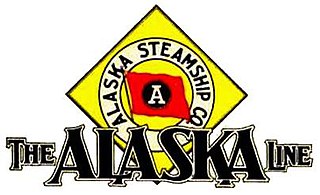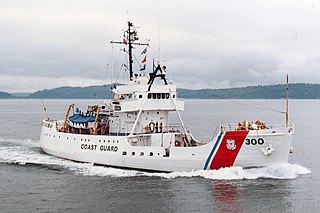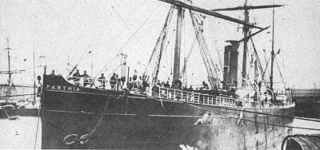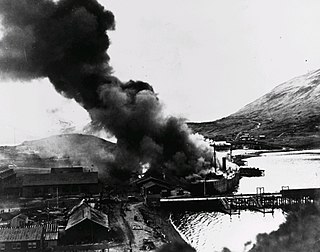
SS Princess Sophia was a steel-built passenger liner in the coastal service fleet of the Canadian Pacific Railway (CPR). Along with SS Princess Adelaide, SS Princess Alice, and SS Princess Mary, Princess Sophia was one of four similar ships built for CPR during 1910-1911.

The Farallon Steamship Disaster was the wreck of a wooden Alaska Steamship Company passenger liner, SS Farallon, that hit Black Reef in Cook Inlet in the Territory of Alaska on 5 January 1910. All on board evacuated to a nearby island, where most had to survive for a month in a mid-winter climate before they were rescued. Six other survivors survived an attempt to row across Shelikof Strait in search of rescue for the stranded men.

SS Winfield Scott was a sidewheel steamer that transported passengers and cargo between San Francisco, California and Panama in the early 1850s, during the California Gold Rush. After entering a heavy fog off the coast of Southern California on the evening of December 1, 1853, the ship crashed into Middle Anacapa Island. All 450 passengers and crew survived, but the ship was lost.

USAT Brigadier General M. G. Zalinski was a U.S. Army transport ship that served in World War II. It sank in 1946 in the Grenville Channel in British Columbia's Inside Passage. The crew were rescued by a tug boat and the SS Catala passenger steamer, but the cargo of bombs and oil went down with the ship.

SS Valencia was an iron-hulled passenger steamer built for the Red D Line for service between Venezuela and New York City. She was built in 1882 by William Cramp and Sons, one year after the construction of her sister ship Caracas. She was a 1,598-ton vessel, 252 feet (77 m) in length. In 1897, Valencia was deliberately attacked by the Spanish cruiser Reina Mercedes off Guantanamo Bay, Cuba. The next year, she became a coastal passenger liner on the U.S. West Coast and served periodically in the Spanish–American War as a troopship to the Philippines. Valencia was wrecked off Cape Beale, which is near Clo-oose, on the west coast of Vancouver Island, British Columbia, on 22 January 1906. As her sinking killed 100 people, some classify the wreck of Valencia as the worst maritime disaster in the "Graveyard of the Pacific", a famously treacherous area off the southwest coast of Vancouver Island.

The Grand Trunk steamship Prince Rupert and her sister ship SS Prince George served the coast of British Columbia and Alaska. Prince Rupert had a 45-year career serving northern ports from Vancouver, British Columbia, from 1910 to 1955. The ship was considered "unlucky" and suffered several incidents during her career, including two significant ones that left large portions of the vessel underwater. The ship was broken up in 1956.

SS Catala was a Canadian coastal passenger and cargo steamship built for service with the Union Steamship Company of British Columbia.

Neva was the British merchant ship Thames, launched in 1801, that the Russians bought in 1803, and renamed Neva. She participated in two trips to the Far East, the first of which was the first Russian circumnavigation of the world. She was wrecked in January 1813.

The Alaska Steamship Company was formed on August 3, 1894. While it originally set out to ship passengers and fishing products, the Alaska Steamship Company began shipping mining equipment, dog sleds, and cattle at the outbreak of the Klondike Gold Rush of 1897. The company was purchased by the Alaska Syndicate and merged with the Northwestern Steamship Company in 1909, but retained its name, and the fleet was expanded to 18 ships. During World War II, the government took over the company's ships. When the war ended, the company struggled to compete with the new Alaska Highway for passengers and freight. It discontinued passenger service altogether in 1954 and shut down operations in 1971.

USCGC Citrus (WAGL-300/WLB-300/WMEC-300) was a Cactus (A)-class seagoing buoy tender built in 1942 in Duluth, Minnesota, and now operated by the navy of the Dominican Republic.

SS Aleutian was a passenger ship in North American coastal service. Built in 1899 for the Ward Line as SS Havana, she would later serve the building of the Panama Canal as SS Panama and ultimately enter Alaskan service as SS Aleutian.

The SS Parthia (1870–1956) was an iron-hulled transatlantic ocean liner built for the Cunard Line by William Denny and Brothers in Dumbarton, Scotland. Her sister ships were the Abyssinia and Algeria. Unlike her two sisters, Parthia was smaller, built in a different shipyard and had a slightly different funnel arrangement. The Parthia was retired by Cunard in 1883 and sold to John Elder & Co., who subsequently transferred her to the Guion Line. After serving with the Guion Line and operating on transpacific routes with the Canadian Pacific Railway Company, she was refit and renamed Victoria.

The SS Northwestern, originally SS Oriziba, was a passenger and freight steamship launched in 1889 by the Delaware River Iron Ship Building and Engine Works, Chester, Pennsylvania which spent most of its career in service in the waters of the Territory of Alaska. The ship from early in its career had a reputation for trouble, and was frequently involved in groundings, collisions with other ships, and with port facilities. She first served as a transport in the West Indies as Oriziba, and was acquired by the Northwestern Steamship Company in 1906, sailed around Cape Horn, and renamed Northwestern. For the next thirty years she worked along the Alaska coast, transporting people, mail, and goods, as well as ore from mining operations at Kennecott.

USFS Eider was an American motor schooner in commission in the fleet of the United States Bureau of Fisheries from 1919 to 1940 and, as US FWS Eider, in the fleet of the U.S. Fish and Wildlife Service from 1940 to 1942 and again in the late 1940s. She ran a passenger-cargo service between Unalaska and the Pribilof Islands, and also carried passengers, supplies, and provisions to destinations on the mainland of the Territory of Alaska and in the Aleutian Islands. She occasionally supported research activities in Alaskan waters and the North Pacific Ocean, and she conducted patrols to protect Alaskan fisheries and marine mammals. In 1924, she provided logistical support to the first aerial circumnavigation of the world.

Recreational dive sites are specific places that recreational scuba divers go to enjoy the underwater environment or for training purposes. They include technical diving sites beyond the range generally accepted for recreational diving. In this context all diving done for recreational purposes is included. Professional diving tends to be done where the job is, and with the exception of diver training and leading groups of recreational divers, does not generally occur at specific sites chosen for their easy access, pleasant conditions or interesting features.
West Niger was a steam cargo ship built in 1919–1920 by Southwestern Shipbuilding Company of San Pedro for the United States Shipping Board (USSB) as part of the wartime shipbuilding program of the Emergency Fleet Corporation (EFC) to restore the nation's Merchant Marine. The freighter spent her entire career in the Pacific connecting the West Coast of the United States with the Chinese and Japanese ports in the Far East. Early in 1928 the ship together with ten other vessels was sold by the Shipping Board to the States Steamship Co. and subsequently renamed Nevada. In September 1932 the vessel while on her regular trip to Japan ran aground in foggy weather on Amatignak Island and subsequently broke into three parts and sank with the loss of thirty four out of thirty seven men.















